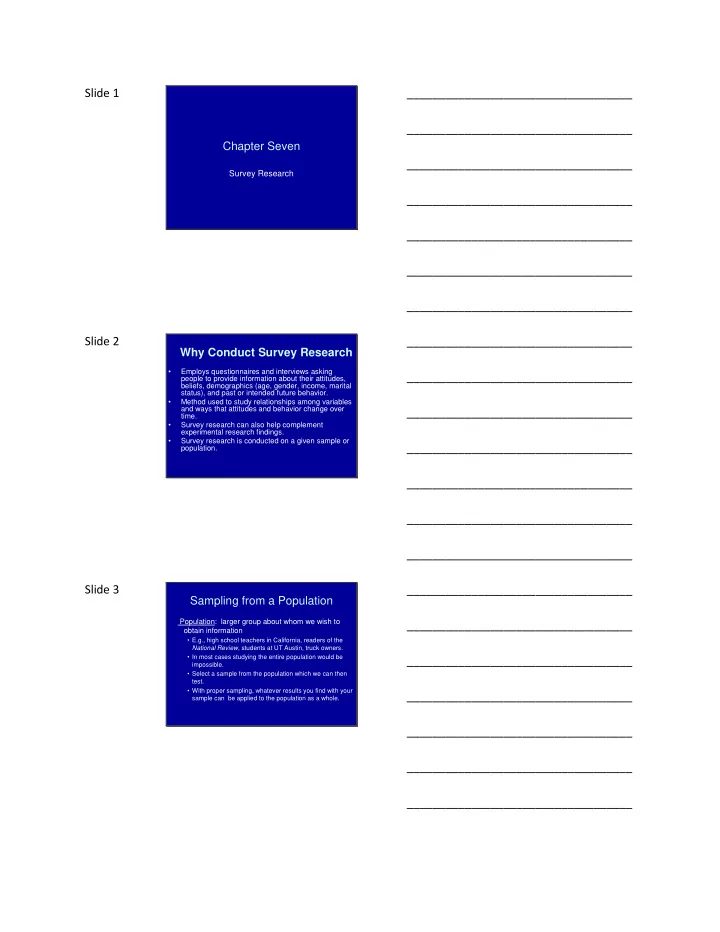

Slide 1 ___________________________________ ___________________________________ Chapter Seven ___________________________________ Survey Research ___________________________________ ___________________________________ ___________________________________ ___________________________________ Slide 2 ___________________________________ Why Conduct Survey Research • Employs questionnaires and interviews asking ___________________________________ people to provide information about their attitudes, beliefs, demographics (age, gender, income, marital status), and past or intended future behavior. • Method used to study relationships among variables and ways that attitudes and behavior change over ___________________________________ time. • Survey research can also help complement experimental research findings. • Survey research is conducted on a given sample or ___________________________________ population. ___________________________________ ___________________________________ ___________________________________ Slide 3 ___________________________________ Sampling from a Population Population: larger group about whom we wish to ___________________________________ obtain information • E.g., high school teachers in California, readers of the National Review , students at UT Austin, truck owners. • In most cases studying the entire population would be ___________________________________ impossible. • Select a sample from the population which we can then test. • With proper sampling, whatever results you find with your ___________________________________ sample can be applied to the population as a whole. ___________________________________ ___________________________________ ___________________________________
Slide 4 ___________________________________ Confidence Intervals • Confidence interval the interval within ___________________________________ which your true/population score lies. • This interval gives you information about the likely amount of error in your findings. ___________________________________ • When using a sample population, the obtained score is not the true score of the population. • sample value your best estimate of ___________________________________ the population value ___________________________________ ___________________________________ ___________________________________ Slide 5 ___________________________________ Sample Size • Larger sample sizes reduce the size of the ___________________________________ confidence interval thereby reducing the amount of sampling error . • Determined by using a mathematical formula ___________________________________ that takes into account the size of the confidence interval and population of interest. • Homogeneous vs. Heterogeneous Populations. ___________________________________ ___________________________________ ___________________________________ ___________________________________ Slide 6 ___________________________________ Sampling Techniques • Probability sampling each member of ___________________________________ the population has a specifiable probability of being chosen. ___________________________________ • Nonprobability sampling we don’t know the probability of any particular member of the population being chosen ___________________________________ ___________________________________ ___________________________________ ___________________________________
Slide 7 ___________________________________ Probability Sampling • Simple random sampling every member of ___________________________________ the population has an equal chance of being selected. • Stratified random sampling used when it is important to ensure that subgroups within a ___________________________________ population are adequately represented in the sample . • Cluster sampling rather than randomly sampling from a list of individuals, the ___________________________________ researcher can identify “clusters” of individuals and then sample from these clusters ___________________________________ ___________________________________ ___________________________________ Slide 8 ___________________________________ Non-Probability Sampling • Haphazard sampling you select a ___________________________________ sample any way that is convenient. • Advantage: it is easy to do • Disadvantage: it might not be a ___________________________________ representative sample of the population, and the survey results might be biased ___________________________________ ___________________________________ ___________________________________ ___________________________________ Slide 9 ___________________________________ Sources of Bias in a Sample • Sampling frame ___________________________________ • Response rate ___________________________________ ___________________________________ ___________________________________ ___________________________________ ___________________________________
Slide 10 ___________________________________ Constructing the Questionaire • Defining the Research Objectives ___________________________________ • Three types of Survey Questions – Content Items – Factual Items ___________________________________ – Behavior Items ___________________________________ ___________________________________ ___________________________________ ___________________________________ Slide 11 ___________________________________ Question Wording • Simplicity ___________________________________ • Double-barreled questions • Loaded questions • Negative wording ___________________________________ • Yea-saying and Nay-saying ___________________________________ ___________________________________ ___________________________________ ___________________________________ Slide 12 ___________________________________ Response to Questions • Closed vs. Open ended questions ___________________________________ • Number of Response Alternatives • Rating Scales • Semantic Differential Scale ___________________________________ • Non-verbal scale ___________________________________ ___________________________________ ___________________________________ ___________________________________
Slide 13 ___________________________________ Finalizing & Administering • Formatting Questionnaire ___________________________________ • Refining Questions • Forms • Ways of Administration: Survey vs. ___________________________________ Interview ___________________________________ ___________________________________ ___________________________________ ___________________________________
Recommend
More recommend